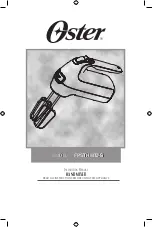
Owner's Manual
17
At the maximum compression, the threshold is set at
0 dBu, and the input to output relationship is
represented by the lower curve. If the input is -5 dBu
(that is, below the threshold), the output is -5 dBu. As
the input reaches 0 dBu, the output is a bit less than
0 dBu. If the input is +5 dBu, the output is about
+2 dBu. If the input r10 dBu, then the output
is +3 dBu. Notice the shapely curve of the soft knee
between the diagonal slope of x = y and the compressor
slope of 6:1 (the compression ratio).
The other blue curves represent in-between positions
of the compressor knob, with higher thresholds before
compression begins.
Outboard compressors often have controls such as
compression ratio, threshold, soft knee/hard knee,
attack time, and release time. These last two affect how
quickly the compressor kicks in when the input exceeds
the threshold, and how quickly it is released after it
drops below the threshold. In this compressor, these
parameters are specially chosen to give you the best
overall performance.
Adjust the threshold carefully, so your dynamic range
is still lovely, without distortion or overload during the
performance. Run through a few practice screams and
high-notes, and adjust the compression as required.
26. COMPRESSOR
Each of the last four mono channels in the
VLZ3 4•Bus mixer has an in-line compressor circuit
with a variable threshold. This is very useful for
compression of vocals, and snare drums, for example,
so you might consider connecting your microphones
and drum mics to these channels, rather than other
channels.
When the incoming signals exceed the threshold level
set by this knob, the signal level is automatically
compressed. This reduces the dynamic range, and
reduces the chance of distortion due to overloading the
input signals.
Dynamic range is the difference in level
between the quietest and loudest parts of a
song. A compressor "squeezes" the dynamic
range, resulting in an overall steadier, more
constant volume level for the signal. It helps sources,
such as vocals, "sit" properly in the mix; it is very useful
for live sound.
The compression ratio is fixed at around 6:1, with
a soft knee response. The threshold can be adjusted
clockwise from off (no compression) to 0 dBu (max).
As an example, suppose the threshold is set to
maximum. An incoming signal reaches the threshold of
0 dBu. As it increases beyond the threshold, it becomes
compressed at a ratio of 6:1. This means that even if the
input further increases by 6 dB, the actual output only
increases by 1 dB. This compresses the output signal, so
there is more protection to your system from distortion
and overload due to poor microphone technique (say
it ain't so) and general pops, bangs and heavy metal
screaming. The soft knee means that the compression
slowly ramps up to 6:1 from the threshold. It does not
jump abruptly to 6:1, as this would be hard knee
compression, and harder on the ears too.
The graph on this page shows the input signal level
going into the compressor, versus the output level
coming out of it. It is the typical graph to see when
compressors are discussed, and is just the kind of thing
our engineers like to discuss during the company
Christmas party*.
If the compressor is off, then the input = output. For
example an input signal level of +5 dBu results in an
output level of +5 dBu. The diagonal line from lower left
to upper right represents x = y, that is, input = output.
+20
-10
-5
+0
+5
+10
+15
+20
-10
-5
+0
SLOPE 6:1
SOF
T KNE
E
SL
OP
E 1
:1
+5
+10
+15
INPUT SIGNAL STRENGTH dBu
O
U
TP
U
T
S
IG
N
A
L
S
TR
EN
G
TH
d
Bu
* My High School math teacher, Mr. Marvin, thought that
graphs might come in handy for me one day. Finally!
















































